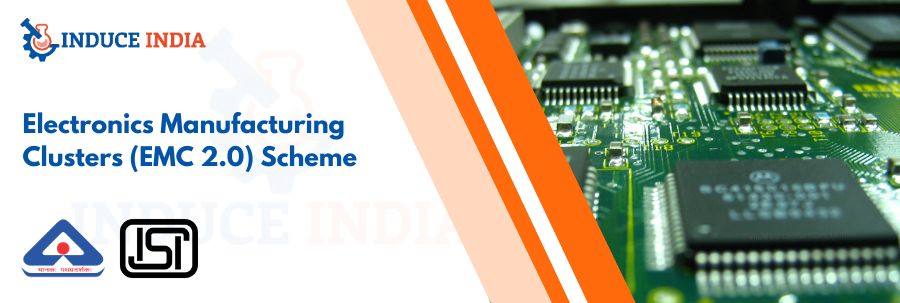India is increasingly becoming the electronics manufacturing capital of the world. With a vast multitude of electronic goods needed, ranging from smartphones to semiconductors, there is always a precedent for a strong and localized production ecosystem. Against such a backdrop, the Government of India put forth the concept of the Electronics Manufacturing Clusters (EMC 2.0) Scheme to further strengthen domestic manufacturing capabilities through world-class infrastructure and common facilities.
At Induce India, our main focus is to bring such transformative policy constructs and growth-oriented schemes to light, which constitute options for business, investment, and stakeholders at the state level. The EMC 2.0 Scheme is one such forward-looking intervention that holds much promise for industrial and economic growth in India.
About EMC 2.0 Scheme
EMC 2.0 is an upgraded version of the original EMC Scheme introduced in 2012, with emphasis on the creation of specific zones, i.e., electronics manufacturing clusters that provide the required infrastructural facilities and amenities for the production of electronics. The second version of the scheme was introduced by the Ministry of Electronics and Information Technology in the year 2020.
Categories of projects under EMC 2.0
-
Greenfield Clusters
These are wholly virgin industrial zones, i.e., on lands that have not been utilized before. The intention is to create integrated facilities from scratch to attract manufacturing units.
-
Brownfield Clusters
This entails upgrading existing electronics manufacturing zones with improved roads, power supply, water systems, and waste management so that they operate efficiently.
-
Common Facilities Centers (CFCs)
These are shared infrastructures, including R&D labs, testing facilities, skill development centers, and logistic hubs, that provide support to several companies, especially MSMEs.
Objectives of the EMC 2.0 Scheme
The EMC 2.0 scheme aims to develop the electronics sector on the path of self-reliance while making Indian manufacturing globally competitive.
-
Creation of Modern Infrastructure
Establishing industrial parks equipped with modern facilities would bring down entry barriers for manufacturers, thereby reducing their production time.
-
Investment Attraction
With a reliable ecosystem in place for electronics production, the scheme aims to promote investments from both the equity players of Indian as well as foreign origin.
-
Promote MSMEs and Start-Ups
Common resources available in the clusters provide the smaller companies and start-ups access to services in testing, R&D, certification, etc., without them having to bear the heavy-cost investments in these activities on their own.
-
Encourage Innovation and R&D
The scheme facilitates shared R&D infrastructure to support product development and compete with innovation centers worldwide.
-
Provide Employment and Skill Development
The scheme intends to employ thousands directly and indirectly and develop skills development by various institutes through skilling programs.
Financial Assistance and Incentives
With a view to economically sustaining the EMC 2.0 Scheme and keeping the incentives attractive to the stakeholders, the Government of India has allotted large-scale funds and created corresponding incentives.
Budget Specifics
- Total Outlay: ₹3,762.25 crore to be spent over eight years (2020–2028).
- ₹3,725 crore for grants-in-aid.
- ₹37.25 crore for administrative expenses.
Funding Breakdown
- Greenfield Projects: Up to 50% of cost, with a ceiling of ₹50 crore per 100 acres
- Brownfield Projects: Up to 75% of the cost, with the same ceiling of ₹50 crore.
- Common Facility Centers (CFCs): Based on the infrastructure offered and its scale.
These monies go a long way in lessening the burden of cluster developers and thereby fast-tracking the implementation of projects. Induce India actively shares financing models and case studies and provides real-time data to all stakeholders so that they understand the various ways in which these incentives can be availed.
Expected Benefits and Long-Term Impact
With the full implementation of EMC 2.0, India shall see marked transformational effects in its electronics manufacturing ecosystem.
-
Promotion of Local Manufacturing
This scheme deters imports and encourages the production of both components and finished goods within the country.
-
International Competitiveness
Being cheaper and more operational, Indian electronics products will be able to compete fairly in the international markets.
-
Balanced Regional Development
Clusters will be spread across various states to industrialize away from metro cities, thus ensuring balanced economic development.
-
Integrated Supply Chain
Clustering involves the co-location of suppliers, assemblers, logistics, and service providers, which enhances speed with less cost.
-
Employment Creation and Skill Development
New manufacturing zones and CFCs will create jobs and give ongoing opportunities for skills training.
Induce India, through its ongoing analysis and coverage, assists companies and policymakers in finding out the real-world implications of such government-led initiatives.
Implementation and Governance
The EMC 2.0 Scheme is structured to ensure timely implementation and strict monitoring so that all objectives of the project are achieved.
Who Can Apply?
- State governments and the industrial development bodies under the state governments.
- Public sector units and industrial area development organizations.
- Private developers (on a PPP basis).
Application Procedure
- The project proponent has to submit an elaborate proposal consisting of information on land availability, investment expected to be generated, possibility of employment generation, and infrastructure.
- The proposal is then evaluated by MeitY and PMAs.
- The proposal receives approval and phased funding based on achievement against milestones as detailed in the progress report.
Monitoring and Evaluation
All projects are monitored by MeitY and PMAs to ensure the efficient use of funds and the timely completion of developments. Periodic reviews of reports are conducted to ensure transparency and accountability.
Induce India provides information regarding cluster approvals, policy amendments, and timelines to stakeholders to keep them informed and aligned with compliance.
How to Participate
Companies, MSMEs, startups, and industrial developers can participate in EMC 2.0 in the following ways:
- Working with their respective state industrial development agencies
- Engaging in partnerships with other enterprises for the development or establishment of electronics clusters
- Forming consortia/Public and private partnerships (PPP) to build Common Facility Centres (CFCs)
- Preparing detailed project proposals indicating land availability, infrastructure requirements, details of investments, and employment potential
At Induce India, our task is to serve as a bridge between policy and participation. While the scheme is implemented by the Government of India, Induce India is there to give insights, updates, and directional inputs to engage businesses, developers, and innovators in such national-level initiatives effectively.
Conclusion
The Electronics Manufacturing Clusters (EMC 2.0) Scheme is a stepping stone toward making India a global hub for electronics design and manufacturing. It promotes innovation, job creation, and economic resilience by creating good industrial zones and reducing land cost and cluster development cost while also providing Common Infrastructure.
As supply chains are shifting globally and are looking for varied and trustworthy manufacturing destinations, India, with key policy enablers like EMC 2.0 and supporting platforms like Induce India, stands tall.
Regardless of your period of investment or Entrepreneurship, the EMC 2.0 Scheme will act as a door into the future of India’s industrial landscape. Stay connected with Induce India for the latest updates, investment trends, and practical insights into how to be a part of India’s electronics growth story.



